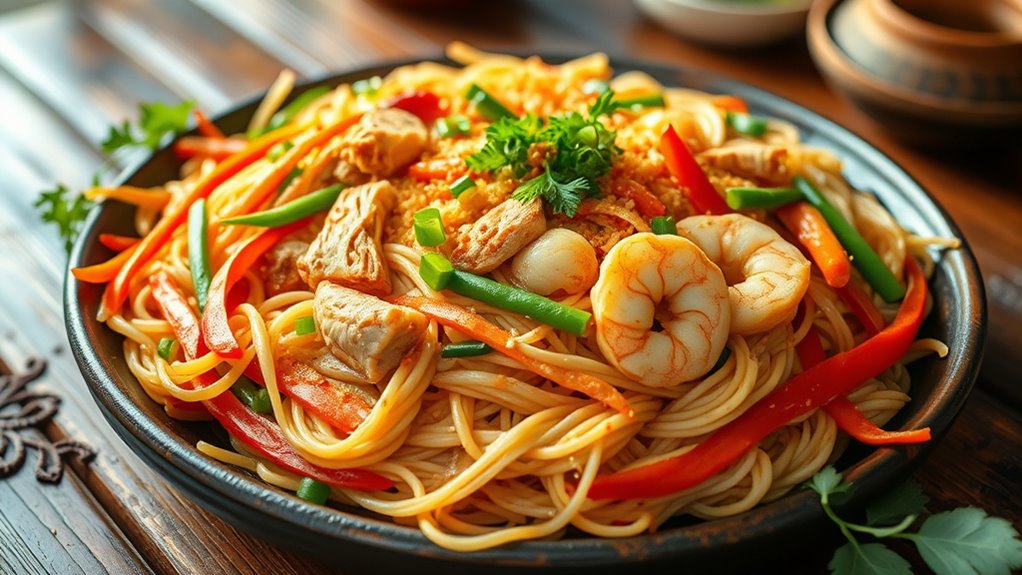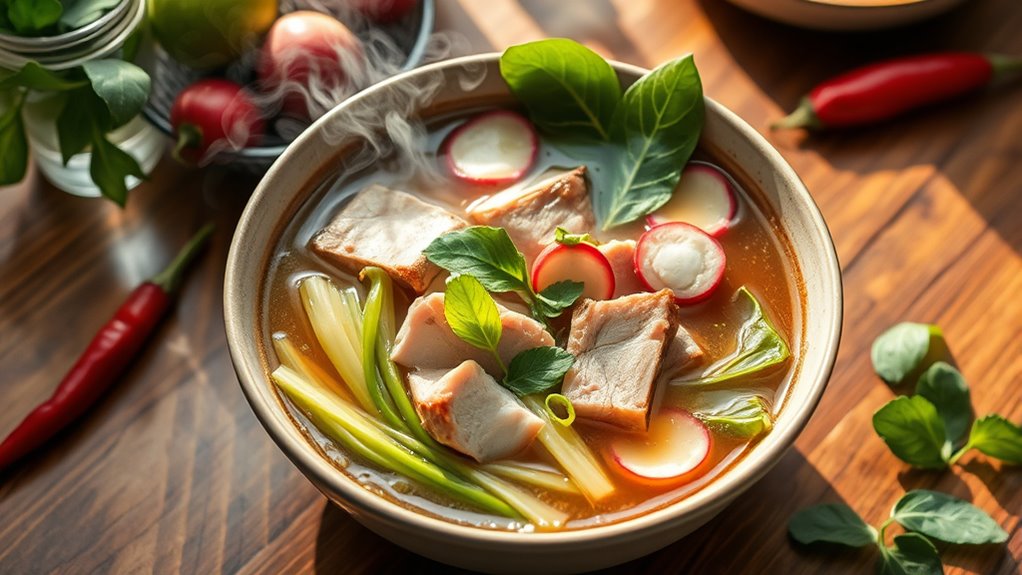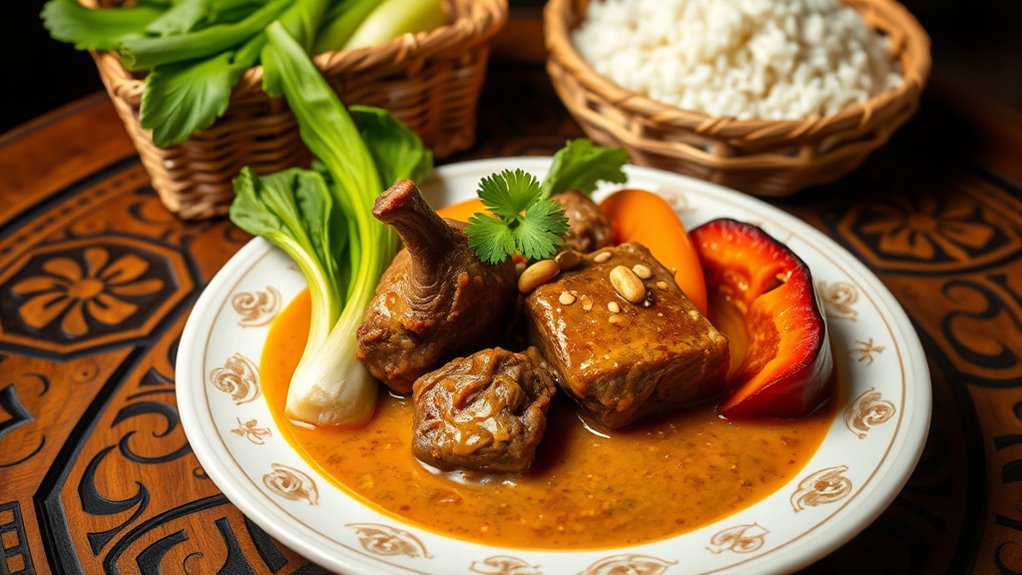To impress your Filipina partner, start with lechon, the ultimate centerpiece for celebrations. Follow it up with adobo, a comforting dish bursting with flavor. Don’t forget pancit for a touch of tradition and longevity. Sinigang offers a warm, sour soup to share, while kare-kare’s rich peanut sauce will captivate her taste buds. Finish off with halo-halo, a delightful mix of sweets. Keep exploring these dishes to create a memorable dining experience together.
Key Takeaways
- Cook Lechon as an iconic centerpiece to celebrate special moments and honor your Filipina partner’s culinary heritage.
- Prepare Adobo, a comforting dish that showcases rich flavors and can be tailored to her protein preferences.
- Serve Pancit during gatherings to symbolize longevity and strengthen your bond through shared meals.
- Make Sinigang for a warm, sour soup that brings comfort and embodies family togetherness.
- Delight her with Halo-Halo, a refreshing dessert that highlights Filipino hospitality and creativity in flavors.
Lechon: The Showstopper for Special Occasions
When it comes to celebrating special occasions, nothing quite compares to lechon, the iconic centerpiece of Filipino feasts. This whole roasted pig embodies joy and community, often marking significant events.
You might find variations like Cebu Style lechon, stuffed with lemongrass and bay leaves, or the more manageable lechon belly, perfect for smaller gatherings.
Lechon sa hurno offers a simpler oven-roasted alternative, ensuring everyone can enjoy this beloved dish. Regardless of the style, each version showcases the rich culinary diversity of the Philippines.
Serving lechon not only satisfies the palate but also strengthens bonds with loved ones, making it a must-have for any special occasion.
Adobo: A Flavorful Comfort Dish

Adobo stands as a beloved symbol of Filipino comfort food, offering a rich tapestry of flavors that warms the heart and satisfies the soul. This dish combines core ingredients like vinegar, soy sauce, garlic, bay leaves, and black pepper, creating a perfect balance of sweet, sour, salty, and spicy notes.
You can use chicken, pork, fish, or even vegetables, depending on your partner’s preferences. Marinating the protein allows the flavors to meld beautifully. Simmering the mixture on low heat guarantees tenderness and richness in every bite.
For an extra twist, consider adding coconut milk for creaminess or chili for spice. Serve it over steamed rice, and watch your partner’s face light up with joy!
Pancit: Noodles for Longevity and Celebration

After enjoying the comforting flavors of adobo, you might want to try pancit, another iconic Filipino dish that celebrates life and togetherness.
Originating from Hokkien cuisine, pancit symbolizes longevity and is a must-have at birthdays and special occasions. With various types like pancit canton, bihon, and palabok, you can easily find a version that suits your taste.
This dish typically features a mix of vegetables, meats, and flavorful sauces, making it both nutritious and delicious. Cooking techniques like stir-frying and sautéing garlic and onions create a savory base that enhances the dish. Additionally, sharing a bowl of pancit is reminiscent of the way Polish comfort food brings people together through shared meals.
Sharing a bowl of pancit with your Filipina partner not only delights the palate but also strengthens your bond through this cherished culinary tradition.
Sinigang: a Sour Soup With Heart

Sinigang, a beloved Filipino sour soup, warms the heart and brings comfort on any occasion. This dish hails from the Tagalog region and is typically served hot, making it perfect for family gatherings.
You can use pork belly or ribs, but feel free to experiment with fish, shrimp, or chicken. The magic lies in its sourness, often achieved with tamarind, but unripe mango or calamansi can also work wonders.
Toss in vegetables like okra, gabi, and kangkong to add flavor and nutrition. Each spoonful is rich in protein, vitamins, and antioxidants, showcasing the Filipino flair for blending flavors.
When you serve sinigang, you’re not just offering a meal; you’re sharing a piece of Filipino culture.
Kare-Kare: Oxtail Delight With Peanut Sauce

Kare-Kare is a sumptuous Filipino dish that showcases oxtails simmered in a rich peanut sauce, creating a delightful blend of flavors. This dish is a staple at celebrations, symbolizing unity during family gatherings. You’ll need oxtails, peanut butter, annatto seeds, and bagoong to achieve that authentic taste. Add eggplant, bok choy, and long beans for a colorful presentation.
You can use a pressure cooker to tenderize the oxtails quickly, or opt for slow cooking to enhance the flavors. The annatto seeds give it a signature yellow hue, while garlic and onion deepen the taste. Kare-Kare is often served with steamed rice for a truly satisfying meal that your Filipina partner will appreciate!
Halo-Halo: A Refreshing Dessert Experience

When you’re looking for a revitalizing treat on a hot day, halo-halo is the perfect dessert to indulge in. Meaning “mix-mix” in Tagalog, this beloved Filipino dessert is a colorful blend of sweet beans, fruits like jackfruit and bananas, and creamy ube ice cream, all served over crushed ice.
The layering process not only looks appealing but also enhances the flavors with each bite. You can personalize yours with toppings like leche flan and pinipig, making it uniquely yours. Serve it chilled for a rejuvenating experience that embodies Filipino hospitality.
Whether you’re sharing it during family gatherings or enjoying it solo, halo-halo is a delightful way to cool down and savor the sweetness of summer.
Frequently Asked Questions
What Ingredients Are Commonly Used in Filipino Cuisine?
In Filipino cuisine, you’ll find staples like rice and noodles at the heart of every meal.
Meat, including pork, chicken, and fish, plays a crucial role, while coconuts add richness through their milk and oil.
Fresh produce like mangoes, leafy greens, and eggplants bring vibrant flavors.
Don’t forget seafood like shrimp and clams, along with essential condiments like patis and toyo, which elevate the dishes with their unique umami and savory profiles.
How Do I Properly Serve Filipino Dishes?
Imagine the aroma of savory adobo wafting through the air, inviting everyone to gather around the table.
To properly serve Filipino dishes, center them for communal sharing and make sure everyone’s plate is heaped with rice before seconds.
Serve elders first, honoring their role. Use a spoon and fork for eating, and don’t take the last morsel from the communal plate.
Add a variety of sauces to enhance the meal’s flavors.
Are There Vegetarian Options for Traditional Filipino Meals?
Absolutely, there are plenty of vegetarian options in traditional Filipino meals!
You can enjoy dishes like Pancit Canton, which you can make with vegetables and mushrooms, or Monggo Guisado, a hearty mung bean stew.
Tofu Adobo is a great alternative to the classic dish, and Vegan Lumpiang Gulay provides a tasty spring roll option.
With diverse ingredients like jackfruit and mushrooms, you’ll find it easy to create delicious vegetarian meals!
What Beverages Pair Well With Filipino Dishes?
When you’re exploring beverages that pair well with Filipino dishes, consider options like iced tea with adobo for a nice balance.
Calamansi juice is great with sisig, adding a revitalizing citrus touch.
For something sweeter, try Riesling with pancit guisado.
If you’re enjoying kare kare, fresh lemonade cuts through its richness perfectly.
Don’t forget local beer for grilled meats; it’s a classic choice that enhances the overall experience!
How Can I Adjust Spice Levels in Filipino Recipes?
You might worry that adjusting spice levels will compromise the dish’s authenticity, but it doesn’t have to!
Start by using fewer chilies than the recipe calls for, adding more gradually as you taste. Incorporate dairy like coconut cream or yogurt to cool the heat, or balance it with a splash of citrus juice or a pinch of sugar.
Trust your palate, and don’t hesitate to adjust until you find that perfect balance!
Conclusion
As you gather in the kitchen, the aromas of adobo simmering and lechon crackling fill the air, wrapping you both in a warm embrace of flavors. Each dish tells a story, weaving together memories and traditions that bring you closer. When you serve these meals, watch her eyes light up with joy and nostalgia, transforming an ordinary evening into a celebration of love and culture. Cooking for her isn’t just about the food; it’s about creating moments that linger long after the last bite.









